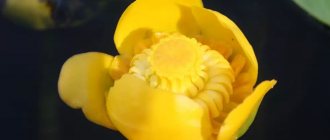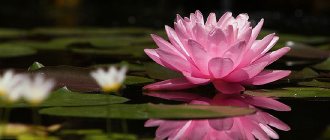Lobelia cardinalis is a fairly rare plant that aquarists use for aquadesign. It is also known in literature as Lobelia blood-red, Lobelia purpurea, Lobelia Mexicana.
This plant, one of the representatives of the Campanula family, can be found in the wild on the coasts of rivers and lakes, as well as in bodies of water with standing water or weak currents. Lobelia can reach a height of 1.2 m, so the tops of plants are often located above the surface of the water. The flowers are formed only in the above-water part and have a bright red color. The flowering period is from mid-summer to mid-autumn. In aquariums, as a rule, lobelia does not bloom, due to the fact that the top is pinched to form a bush.
Description of fiery lobelia
Purple lobelia (Lobelia cardinalis) is an ornamental perennial that prefers moist soil and can grow in water. Its homeland is the tropics and subtropics of America. Distribution area: southwestern USA, southern Canada, Central America, northern Colombia. In the 17th century, lobelia purpurea was brought to Europe, where it received an alternative name, cardinal's, because it matches the color of the robe of Catholic priests.
Lobelia purple, planted in the shade, blooms weakly, and its shoots become thinner and elongated
As you can see in the photo, the stems of blood-red lobelia are erect, their diameter is 2-3 mm. The color changes from green to red. With sufficient lighting, it produces significant growth in the form of lateral shoots, resulting in the formation of a bush with a spherical crown, the diameter of which reaches 1 m. The leaves are small, collected in a basal rosette. Their color varies from light green with a raspberry tint to bright scarlet, depending on age and lighting. The leaf blades are narrow, shiny, with pointed ends, up to 10 cm long. They are located on thin petioles.
The root system is weak and undeveloped. The racemose inflorescences of lobelia are red, pink or purple, on long stalks. The corolla is red, sometimes white, up to 5 cm in diameter.
Aquarium plant lobelia
Blood red lobelia (Lobelia cardinalis) is an aquarium plant that belongs to the bellflower . In nature, blood-red lobelia grows along the banks of slow rivers and in standing reservoirs. This plant can be found in the wetlands of America, Canada and northern Colombia.
Lobelia was used as a medicinal drug by some native Americans. Decoctions and infusions were prepared from it, which were taken to treat various ailments. However, lobelia has not proven itself as a medicine. And the presence of poisonous alkaloids contained in the plant made it dangerous to human health and life.
Description
The stem of the plant is very fleshy and can reach considerable lengths. The leaves are arranged alternately along the stem. The leaf itself is oval in shape and light green in color.
The top of the leaf is bent downwards. The leaf width usually reaches 3 cm, and the length is 7 cm. Veins are visible on the lower surface of the leaf (usually there are 9 of them).
In a room with bright lighting, the undersides of lobelia leaves acquire red-violet hues.
Lobelia root consists of a plexus of thick roots. They are very short and white in color.
Lobelia blooms in beautiful groups of small purple flowers . The inflorescences look very beautiful. The plant begins to bloom in July and ends in October. Lobelia growing in the wild can reach a height of 1.2 meters.
Growing lobelia in an aquarium
Blood red lobelia can be grown in paludariums and aquaterrariums . You can also grow the plant in garden or greenhouse ponds. Under favorable conditions, lobelia very quickly appears on the surface of the water and begins to bloom.
Lobelia needs to be looked after. In order for the plant to grow along the walls of the aquarium, you should pinch its top. Then the lobelia will begin to produce side shoots and will look very thick and beautiful. The plant should be planted along the perimeter of the side and back walls of the aquarium to make it easier for it to rise to the surface of the water.
To breed blood-red lobelia, the water in the aquarium must have a temperature of 20 to 26 ° C. The aquarium must be lit very brightly, otherwise the lobelia leaves will turn yellow.
To illuminate an aquarium, it is better to purchase fluorescent light bulbs with a power of 0.5 W per liter of water. It is recommended to supplement the water for 2-3 hours every day using incandescent lamps with a power of 25-40 W. Lamps should be placed directly above the plant.
For blood red lobelia, the optimal day length is 12 hours.
Lobelia responds well to regular changes of water and the addition of special liquid fertilizers. However, this must be done carefully so as not to damage the plant, because its roots are very weak and are not firmly fixed in the soil.
Blood red lobelia is propagated by seeds and stem division. To do this, the stem has adventitious roots that can easily take root in the soil.
Lobelia grows in tropical and subtropical zones of North America, mainly in swamps, as well as on the banks of rivers and lakes. In nature it blooms from July to September.
Lobelia purpurea varieties
The genus Lobelia includes up to 300 species, about 20 of which are used as ornamental ones. One of them is purple. Today they decorate gardens, parks, and ponds, and the indigenous peoples of America used them for medicinal purposes, since they contain alkaloids. Several varieties and hybrids of Lobelia purpurea are known.
Queen Victoria
The height of plants of the Queen Victoria variety is 90-150 cm, width - 30 cm. The foliage is dark burgundy, with a chocolate tint. The flowers are large, scarlet, collected in racemes. The buds bloom from June to October. The Queen Victoria variety of lobelia purpurea was obtained in Canada as a result of crossing three plant species. The new perennial has high frost resistance (zone 5).
The Queen Victoria variety is decorative before and after flowering
Black Truffle
The Black Truffle variety is distinguished by straight, vertical shoots the color of dark chocolate, which gives the plant a dramatic appearance. The flowers are red, the foliage is purple, gradually turning black and fading. In hot weather it turns burgundy. Flowering lasts from mid-summer to autumn.
Read more Lobelia perennial: planting and caring for the plant in open ground
The Black Truffle variety is especially effective against a light background of ground cover plants.
Russian Princess
A perennial herbaceous plant reaches a height of 60 cm in adulthood. Purple Lobelia Russian Princess blooms in June and July, forming red-pink inflorescences. The foliage has a bronze tint. Decorative value is high, winter hardiness is average.
The Russian Princess variety looks great near an artificial pond
Lobelia fiery
The plant is low, up to 75 cm. The flowers are small, bright red. The Fiery purple lobelia variety (Fulgens Willd) is moderately winter-hardy, but may die in severe frosts. To preserve a perennial, it is dug up, transferred to a cool place with above-zero temperatures, and in the spring it is used for cuttings.
Fiery lobelia requires bright lighting
Reproduction methods
To propagate purple lobelia (Lobelia cardinalis), you can use the seed method or cuttings. If you follow the timing and rules of sowing and rooting planting material in the spring, you can get healthy plants.
Seeds
If you start sowing at the end of January, buds will bloom on the purple lobelia in June. To grow seedlings, it is necessary to perform a number of sequential operations:
- Prepare a container.
- Fill it with a mixture of garden soil, sand and perlite.
- Compact the soil surface.
- Spread the seeds over the surface and cover with a thin layer of soil.
- Cover the box with film.
After two weeks, the first shoots will appear and will need to be thinned out. Seedlings need comfortable conditions - air temperature +20 ⁰C and additional lighting to extend daylight hours to 14 hours. At the age of a month, purple lobelia seedlings are planted. After growing, it is planted, having previously been hardened.
Small, shiny, brown Lobelia purpurea seeds ripen in capsules until late summer
Cuttings
If the seed method does not impart varietal properties to plants, the cutting method is used:
- Cuttings 10 cm long with an oblique lower cut are cut from a successfully overwintered mother bush.
- Place them in a solution of a growth stimulator.
- Prepare a box and a soil mixture consisting of humus, sand and peat mixed in equal parts.
- Place the cuttings into it at an angle, deepening it by 2-3 cm.
- Cover the container with film to create a microclimate.
After two to three months, the cuttings take root and are transplanted into open ground.
Planting methods
Seeds
This planting method has more advantages than disadvantages.
The most important of these is that this species is best suited for planting by seed. Such planting will give quick germination, strong and disease-resistant sprouts. The only drawback is that the seeds are very small, resemble dust and are difficult to collect. In addition, they are difficult to sow - they must be evenly distributed on the surface of the planting container.
Therefore, food containers with a lid are most often used for sowing. They help achieve a greenhouse effect. This helps the seedlings to develop well, but there are also difficulties with further picking of the sprouts.
How to choose seeds?
It is important to collect seeds on time. The collection is carried out during the period when the flower has completely faded:
- Next, 3-4 shoots are tied.
- The seeds from these shoots are knocked onto clean white paper.
Paper bags or glass containers are used to store seeds.
For growing with seeds, you can choose ready-made granulated seeds, which are sold in flower shops. Such seeds are usually planted in peat tablets or cassettes to bypass the picking process.
Sowing procedure
To facilitate the planting process, the seeds must be mixed with sand. The procedure is carried out in February or early March. Cultivation of seeds is carried out in a well-lit place.
Planting is done as follows:
- The planting container should be wide and shallow. It must have drainage holes. 5-6 cm of soil is poured into the container and the top layer is lightly compacted.
- Carry out the first watering of the soil with the addition of a fungicide for disinfection.
- Soak the soil for 10-12 hours.
- Seeds are sown evenly on the ground and not covered with soil on top.
- The crops are sprayed from a spray bottle with water and a weak solution of manganese.
- Cover the container with film and place in a bright, warm place with a temperature of 18-20 degrees.
- Condensation must not be allowed to form. To do this, the crops are ventilated daily.
- After 2 weeks, sprouts appear.
- Water the sprouts only with a spray bottle or by adding water to the tray of the pot.
- After 2-3 leaves appear on the sprouts, pick.
- Seedlings that have reached a height of 3 cm are pinched.
- After warm spring weather sets in, planting in open ground is carried out.
- 5-6 seedlings are placed in one hole.
Cuttings
Propagation by cuttings is a simple, hassle-free procedure and is excellent for propagating this type of lobelia.
Like other planting methods, cuttings have their pros and cons.
The advantages can be safely attributed to:
- speed of the procedure;
- quick and painless rooting;
- preservation of varietal qualities of lobelia.
The disadvantages are:
- maintaining the old bush throughout the winter;
- strict adherence to care rules.
Which cuttings are best to take and how to prepare them correctly?
For cuttings, you need to choose a strong, mature bush with healthy shoots without signs of disease or pest damage.
The size of the cuttings should be at least 10 cm. They need to be cut in the spring. Before planting, they are lowered into Kornevin for 40 minutes.
Planting is done in previously prepared soil. Boarding procedure:
- Cut the cuttings and treat the sections with a growth stimulator.
- Plant in special soil.
- Moisten the seedlings with warm, clean water.
- Cover the seedlings with film.
- Ventilate daily for 20 minutes.
- After 3-4 weeks, rooting will occur.
- Carry out regular, abundant watering.
- Fertilize with liquid complex fertilizers once a week.
- Transplant the seedlings into open ground after 1-1.5 months.
Planting and caring for perennial purple lobelia
If the seedlings look healthy, have at least four true leaves, and the cuttings have taken root and started growing, then it is time to plant. For rapid growth and development, it is necessary to comply with the timing and rules of planting.
When to plant
The optimal time for planting seedlings and rooted cuttings of lobelia purpurea is the beginning of summer, when the threat of frost has passed and the soil has warmed up. In the southern regions, in more comfortable climatic conditions, this is done a month earlier. There is no need to rush into transferring plants into open ground; you need to wait until the night air temperature does not drop below +10 ⁰C.
Read more Lobelia ampelous: planting and care, photos, videos
If lobelia purpurea is planted in shallow water, shelter for the winter is required
Requirements for place and soil
When choosing a location, give preference to an area illuminated by the sun throughout the day. The soil must be constantly moist. Lobelia purpurea develops well on loams or peat bogs, the acidity of which is in the range of 6.1-7.8 pH.
You can place seedlings in containers by preparing a substrate in advance consisting of sand, neutral peat and humus.
How to plant correctly
Lobelia purpurea seedlings are planted in open ground in compliance with a number of rules:
- The selected area is dug up and weeds are removed.
- Make holes up to 25 cm deep, placing them at a distance of 30 cm.
- Drainage made of fine crushed stone is placed at the bottom of each.
- Fertile soil is poured on top.
- Four to five plants are planted in each of the prepared holes.
- Fill the voids with soil mixture and water abundantly.
- The soil surface is mulched with peat, pine needles, hay and grass.
To speed up rooting and protect seedlings from sunburn, create a shelter for several days that can be opened for ventilation.
Important! To obtain soliter plantings of purple lobelia, the gap between the holes is increased.
To obtain seedlings, you can use containers, cassettes, pots and peat tablets
Aftercare
Lobelia purpurea can grow both in soil and in water. In the first case, caring for it should be more thorough and painstaking.
The plant cannot tolerate even temporary drying out of the soil; it must always be moist. Water consumption is 10 liters per 1 m2. Drip watering is considered optimal for lobelia purpurea. After each irrigation, the soil is loosened and mulched.
Fertilizing is applied several times per season:
- in May, after planting - nitrogen;
- during the formation of buds - superphosphate and potassium salt;
- in the second ten days of August - complex mineral fertilizers.
We must not forget about the formation of the lobelia purpurea bush. For this purpose, during the growing season, the tops of the shoots are pinched to stimulate the growth of lateral stems.
How to preserve in winter
The frost resistance of lobelia purpurea is low, therefore, in the central zone of the Russian Federation, measures are necessary to prepare it for the winter period.
In regions with frosts down to -25 ⁰C, bushes are dug up and stored in a basement or underground, where the temperature is not higher than +10 ⁰C.
In southern regions with mild winters, plants are left in the ground. The shoots are cut to 4-5 cm, the base is covered with leaves, and in winter - with snow.
Important! In early spring, the shelter must be removed to prevent the shoots from rotting.
How does cardinal lobelia propagate?
Lobelia can be propagated by cuttings and seeds. In the latter case, it is necessary to grow seedlings. This can be done at home, but special attention should be paid to the soil - it should resemble a muddy bottom.
A simpler method of propagation is cuttings. The stems have many side shoots that can be easily separated. They are characterized by rapid growth, so a new seedling will be obtained in 2-3 months. Cuttings begin in the fall. Sequencing:
- Lobelia purpurea is dug up and stored at home at a temperature of 13-15 ° C, but no more.
- In February, the pot is transferred to normal room conditions.
- At the same moment, the side shoots are removed so that the size of the cuttings is 10-12 cm.
- Make a lower oblique cut and immerse the Lobelia purpurea stalk in a solution that stimulates growth.
- Prepare pots with substrate. Mix peat, sand and humus in equal quantities and moisten the soil.
- Root the cuttings at a slight angle.
- Cover with film or glass to create greenhouse conditions. They are periodically opened slightly so that the seedlings do not rot.
- Constantly provide additional lighting (length of daylight hours is at least 12 hours).
The cuttings grow in 2-3 months, after which (at the end of May) they are transferred to open ground.
It is recommended to pre-treat the seedlings with any fungicide, for example, Fundazol or Fitosporin
Planting and caring for Lobelia cardinalis in an aquarium
Lobelia purpurea is an aquarium plant, so it feels much better in water than on land, and care is not difficult. It is planted along the walls - back or side, placing the roots in rocky soil, where it develops well when certain conditions are created:
- water temperature - +25 ⁰С;
- hardness – 5-15;
- illumination for 10 hours or more;
- neutral reaction.
Important! The tops of Lobelia purpurea are pinched before they reach the surface of the water to prevent flowers from forming above it.
For full development, the plant requires an aquarium with a volume of 40 liters or more.
Advantages and disadvantages
The main noticeable difference between Purple Lobelia is its color. It is highly decorative and can be grown as an aquarium plant and on the banks of reservoirs, in wetlands.
A significant advantage is frost resistance. The disadvantages are a strong dependence on the amount of water. The plant will not bloom without being immersed in water. It also needs a lot of light in order to take on the most beautiful appearance and grow not only with straight stems, but also with lateral shoots.
Diseases and pests
Lobelia purpurea has high immunity, but the foliage and stems are often covered with a white coating. These are the first signs of powdery mildew. If you take action right away, the plants can be saved. To do this, spray with Bordeaux mixture, Topaz, Skor or other fungicides. The procedure is carried out several times with an interval of ten days. Diseased leaves are collected and disposed of.
Read more Lobelia ampelous: planting and care, photos, videos
The main pest for the plant is slugs, which appear in large numbers and destroy young foliage. The best way to combat them is by hand collection. For preventive purposes, small stone chips and eggshells are poured near purple lobelias.
What plants does it go with?
Thanks to the brightness of the inflorescences, purple lobelia can become a noticeable accent in the garden. It is used in group and single plantings, combined with other perennial plants, ornamental shrubs, coniferous and deciduous trees.
An excellent companion for a flower is the annual purple-red cascading lobelia, which is planted in baskets, flowerpots, and flowerpots, creating attractive compositions. Plants are combined with petunias, phlox, asters, marigolds in multi-tiered flower beds, flowerbeds and alpine slides. Decorating a pond with perennials looks no less stylish.
Lobelia purpurea does not bloom in the aquarium, but the foliage looks impressive, especially when the backlight is directed at it. Having planted the plants in the center, use lighter or darker algae as a background.
How to prepare for frost?
Purple lobelia is considered a frost-resistant variety, but for the winter it is necessary to prepare shelter for the bushes:
- In autumn, the stems are cut to the ground. 3–4 cm of branches remain from the soil. The trimmed bush is covered with dry leaves, 15 - 20 cm in height.
- If winters are harsh, then the bushes need to be dug up, transplanted into separate pots and stored in a basement or greenhouse until the onset of spring warmth.
Important! Any shelter must be breathable and have outlets for melting snow. Usually, old wicker baskets, straw mats are used for shelter, or you can cover them with pine spruce branches. - In winter, snow should be placed on the shelter, which is removed with the onset of the first warming.
- In spring, the bushes are freed from shelter; soil loosening and fertilizing are required for active growth. You can feed the flowers with a solution of organic fertilizers.











